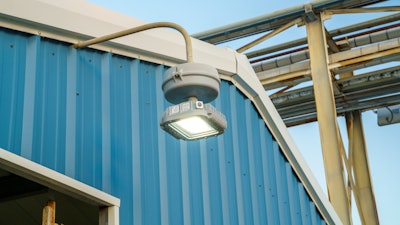
Safety isn’t just a priority during National Safety Month, it’s an imperative at manufacturing facilities every hour, every day of every year. But despite companies’ best efforts and investments, accidents still occur. While the manufacturing sector has improved over time, it remains an inherently dangerous environment with heavy equipment in operation, material handling, excessive noise, and risks around every corner.
With an average of 477,600 injuries and 328 fatalities per year, these incidents cost companies over $17 billion annually in lost time, medical expenses, penalties and legal settlements. In addition to the toll this takes on workers and their families, the known on-the-job risks can be a deterrent when it comes to attracting new employees, which is a serious concern in the face of a significant talent shortage.
Upgrading antiquated lighting to modern, high-efficiency industrial-grade LED fixtures is one way to improve facility safety. With more than 90 percent of U.S. industrial facilities still relying on old school high-pressure sodium (HPS) and other HID sources, there’s a lot of room for improvement in modernizing industrial lighting for the benefit of the planet, the bottom line, and employees.
Here are five ways LED lighting can improve safety in manufacturing facilities.
- Reducing fall risk. Once again, falls from elevation ranked #1 in OSHA’s Top 10 Most Cited Violations list for the 10th consecutive year. The risk of working at height is extremely high, even when following proper procedure. Naturally, because most lighting hangs from the ceiling, lighting maintenance forces staff to work at excess heights. And because HPS lighting fails frequently in harsh environments, it requires nearly non-stop maintenance, putting workers at risk with every bulb change. At Rubis Terminal’s European facilities, that meant workers had to build scaffolding and work at high elevation in teams of two with portable lighting, just to change lightbulbs—a significant safety risk. Upgrading to longer-lasting LED lighting can reduce the risk of falls during lighting maintenance.
- Eliminate toxic exposure. Aside from the fall hazard involved in lighting maintenance, broken HPS bulbs are an often overlooked risk to employees. A single HPS lamp contains 10-15 milligrams of mercury[1]. When maintenance staff accidentally break a bulb, which happens often, this exposure can cause acute symptoms like nausea, vomiting and abdominal pain, and long-term affects. LEDs, by contrast, contain no mercury or other harmful toxins, therefore mitigating this risk for employees. It also eliminates the associated environmental damage, which makes them a much more sustainable lighting option.
- Improve tripping hazard detection. Slip and trip accidents are the most common cause of lost time accidents, which is the direct result of poor lighting[3]. When workers can’t see obstacles, it’s difficult to avoid them. In many cases, poor lighting forces employees to use supplemental or portable lighting. That means dealing with light trees or extension cords or working with just one hand because they’re forced to hold a flashlight—both of which add to the accident risk. According to the Centers for Disease Control and National Institute for Occupational Safety, LED lighting has proven to enhance trip-hazard detection by nearly 24 percent and allow staff to detect tripping hazards 94 percent faster than conventional lighting. By providing better illumination, employees can see hazards before accidents happen and end their reliance on portable lighting and flashlights.
- Better visibility. HPS lighting is known for its unnatural orange color, which makes it difficult to distinguish colors. This can be a problem when color-coding is used to identify hazards, such as on warning labels, placards, tubing or wiring. Unable to discern blue from red, for example, an electrician may accidentally cut a live wire with disastrous consequences. LEDs emit a bright, white light that mimics natural daylight. This not only allows workers to easily distinguish colors, but also eliminates the need for supplemental lighting to achieve the color acuity needed to make safe decisions.
- Reduce fatigue. Especially in facilities with 24-hour operations, worker fatigue creates a tremendous safety risk. When employees are tired, they’re less engaged, more likely to take shortcuts in following proper procedure and their reaction time is slowed, making them less able to detect and avoid hazards—and more prone to accidents[4]. Some may flat out fall asleep on the job, putting themselves and others at risk. On the other hand, studies show that the crisp, near-daylight illumination provided by LEDs reduces fatigue by 5X[5] and actually encourages alertness by suppressing melatonin levels. In fact, LEDs have shown to improve human cognition, accelerate task completion, and improve productivity[6].
Regardless of industry, every manufacturer should make employee safety a top priority. And sometimes the answer is as simple as looking up.
Fariyal Khanbabi is the CEO and Chairman of Dialight Group CEO & Chairman of Dialight Foundation.
[1] Osram, GE, HPS product specifications
[2] U.S. Dept. of Labor, Occupational Safety and Health Administration 29 CFR 1910.1000, Table Z-2; ECG analysis
[3] U.S. Dept. of Labor, Census of Fatal Occupational Injuries Summary, 2016; Occupational Health and Safety Administration, Mine Safety and Health Administration
[4] Edwards, NREL, “A Literature Review of the Effects of Natural Light on Building Occupants”
[5] Falchi, ““Limiting the impact of light pollution on human health, environment and stellar visibility”
[6] Bingelli, Building Systems for Interior Designers, Industrial Buildings 2003






















